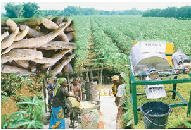
www.chinaview.cn 17 November 2008
PONGNEA LEU, Cambodia, Nov. 17 (Xinhua) -- Cambodia opened its first ethanol factory to generate bio-fuel from cassava flour here on Monday. "This is the first ethanol factory in Cambodia and it will become the market place of cassava product for local farmers," Prime Minister Hun Sen said at the opening ceremony of the pioneer venture invested by the MH Bio-energy Group of South Korea.
It will directly provide 192 job opportunities for local workers and encourage farmers to plant more cassava, he said, adding that the factory itself has made investment to grow cassava on 8,000 hectares of land in Kampong Speu province.
The project, with 40 million U.S. dollars of investment, has already opened two branches in Kampong Cham and Battambang provinces to purchase cassava from local farmers, he added.
Industry, Mines and Energy Minister Suy Sem said at the ceremony that the factory now has a designed capacity of 36,000 tons of ethanol fuel for export per year, especially to the European market. "The factory has a plan to double its export volume during the next few years. It now needs about 100,000 tons of dry cassava flour each year," he said, adding that its ethanol fuel can replace gasoline for vehicles.
Sar Peov, head of the administration unit of the factory, told Xinhua that a ton of ethanol fuel currently sells at about 700 U.S. dollars on the international market.
"We focus on foreign market because Cambodia has a small market for ethanol products and the vehicles here use gasoline and diesel," he said. We will focus on the Cambodian market later, he added. Cassava is one of the most important economic crops in rural Cambodia.
According to the official figures, around 30,000 hectares of land were planted with cassava in 2005 in the kingdom, with a turnout of around 536,000 tons of flour.
Editor: Deng Shasha



